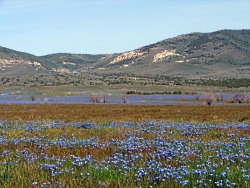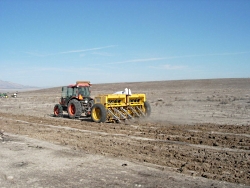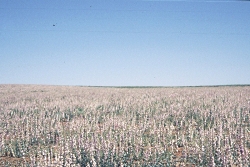
furrows left by new seeding.
Devil’s Playground Fire, Box Elder Co.
Courtesy & Copyright 2012
Nancy Shaw, Photographer
 Blue flowers of wild flax
Blue flowers of wild flax
years after seeding
of Devil’s Playground.
Courtesy & Copyright 2012
Jim Cane, Photographer
 Seed being planted after fire
Seed being planted after fire
using a rangeland drill.
Scooby Fire, Box Elder Co.
Courtesy & Copyright 2012
Nancy Shaw, Photographer
 Native grasses established
Native grasses established
two years after
seeding Scooby Fire.
Courtesy & Copyright 2012
Jim Cane, Photographer
 Native sweetvetch farmed
Native sweetvetch farmed
for seed production.
Courtesy & Copyright 2012
Jim Cane, Photographer
 Palmer penstemon farmed
Palmer penstemon farmed
for seed production.
Courtesy & Copyright 2012
Bob Hammon, Photographer
More than 7 million acres burned this summer across the western United States. It’s the biggest fire year since 2007. In Utah, wildfires blazed across 450,000 acres, as much land as the urbanized Wasatch front. Most of these fires scorched basin and foothill habitats dominated by sagebrush or juniper forests. After a year or two, the blackened land will turn green. But shrubs and trees in these basin habitats are frequently killed by fire. Where these native plant communities naturally recover, it’s because perennial wildflowers and grasses resprout, and, like the shrubs, germinate their seeds. However, overgrazing a century ago impoverished many western rangelands. Aggressive weeds from Europe and Asia could then invade, such as tumblemustard, Russian thistle, and red brome or cheatgrass. These weeds outcompete our natives, multiplying with each fire cycle to eventually carpet the landscape.
To stem this tide of weed invasion after fire, land managers assist plant community recovery by planting mixtures of shrub, grass and wildflower seed. The shrub seed is mostly native, harvested from the wild by private seed collectors. The tiny seeds of several kinds of sagebrush prevail, often mixed with fourwing saltbush, shadscale, or bitterbrush.
The grasses are largely farmed by specialty growers. In past decades, these were mostly tough, competitive grasses from the Asian steppe, notably crested and tall wheatgrasses, and Russian wildrye. These practical, affordable grasses stand up to cheatgrass, but they also impede the return of the native flora. Today, half the grass seed applied after Great Basin fires includes natives, such as Sandberg bluegrass, squirreltail, Indian ricegrass, and bluebunch wheatgrass.
Use of wildflower seed has lagged. It’s challenging to farm yet costly to wild harvest. Today, a handful of innovative farmers are growing native wildflowers for seed, such as yarrow, Lewis flax, sweetvetch, two prairie-clovers, a milkvetch, and several penstemons. How much seed is needed? After the big fire year of 2007, four thousand tons of shrub, grass and wildflower seed were planted in the American West!
This is Linda Kervin for Bridgerland Audubon Society.
Credits:
Images: Courtesy & Copyright Nancy Shaw
Courtesy & Copyright Bob Hammon and
Courtesy & Copyright Jim Cane
Text: Jim Cane, Bridgerland Audubon Society
Additional Reading:
https://wildfiretoday.com/page/2/
https://www.fs.fed.us/rm/boise/research
/shrub/greatbasin.shtml
https://www.fs.fed.us/rm/boise/research/shrub
/projects/plant_guides.html
Forero, Leslie, Plants Surviving Cheatgrass Invasion May Improve Restoration Chances, Study Shows, UPR Utah Public Radio, Feb 26, 2018 https://www.upr.org/post/plants-surviving-cheatgrass-invasion-may-improve-restoration-chances-study-shows
